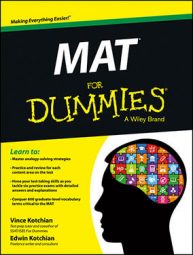When it comes down to it, analogies are pretty simple: They’re just relationships between words (and sometimes between numbers). Your job for any MAT analogy question is just to recognize the relationship presented to you and find its match among the answer choices. Easy, right?
The only problem is that sometimes you may not recognize the presented relationship, its match, or even some or all of the terms in the question! The first step in dealing with any MAT analogy, however, is identifying its structure. If you don’t correctly determine its structure, you may create a relationship between the wrong terms.
MAT analogies fit into just two structural types: 1:2,3:4 and 1:3,2:4. In a 1:2,3:4 analogy, the first and second terms in the question have a relationship, and the third and fourth terms in the question have the same relationship.
To help you recognize the structure of a 1:2,3:4 analogy, here is an example. Take a minute to wrap your head around this notation if it’s confusing — it’s important to understand before you move on.-
Fitzgerald : literature :: Monet : _________________
-
(A)fishing
-
(B)philosophy
-
(C)art
-
(D)music
-
You may realize this is a 1:2,3:4 analogy structure instead of a 1:3,2:4 structure, either by recognizing the strong relationship between Fitzgerald and literature or by reasoning that Fitzgerald and Monet don’t have a clear or compelling relationship.
Although you could write a sentence linking F. Scott Fitzgerald, a famous American writer, to Claude Monet, a famous French painter, the relationship between the two men is not obvious, other than that they’re both famous. The correct answer is Choice (C), art. Claude Monet, a famous artist, created art, just as Fitzgerald, a famous writer, created literature.By the way, a MAT question’s structure will never be 1:4,2:3, though you sometimes may think you see that type of relationship. For instance, the following question is an attempt to trick you into creating a 1:4,2:3 relationship:
-
_________________ : 6 :: billion : million
-
(A)6
-
(B)9
-
(C)10
-
(D)100
-
You may think about picking Choice (A), reasoning that the first and fourth terms (6 and million) have a similar relationship to the second and third terms (6 and billion). However, MAT analogies can’t, don’t, and won’t have that structure.
Also, there’s not much of an argument that the relationship between 6 and million can be the same relationship as in 6 and billion, and hopefully if you tried to create a sentence for that relationship, you realized it was weak.The right answer is Choice (B), 9, making the analogy a 1:3,2:4 (a billion has nine zeroes and a million has six zeroes).
Even if, in your mind, the first and fourth or second and third terms of an analogy have the most beautiful relationship in the world, remember that it’s not meant to be. 1:4,2:3 relationships don’t exist on the MAT.

